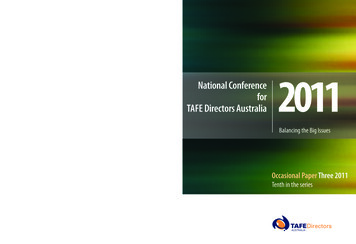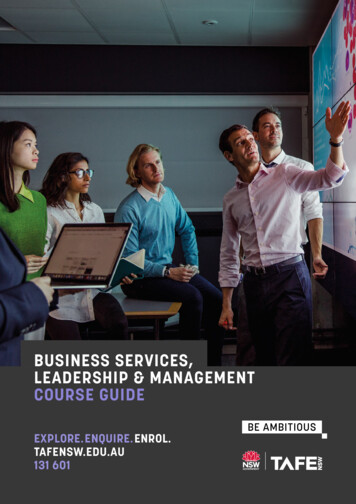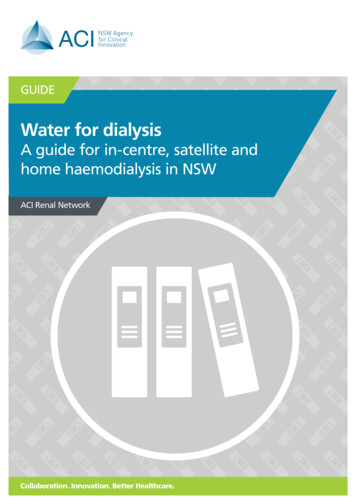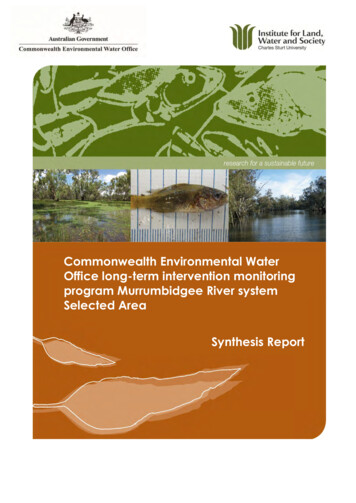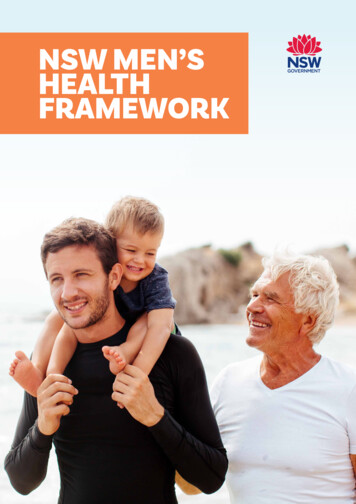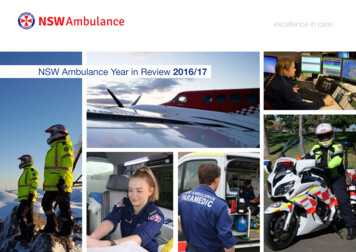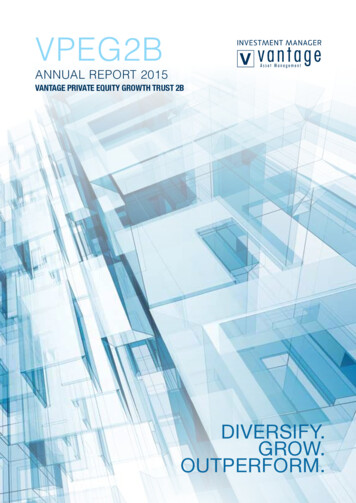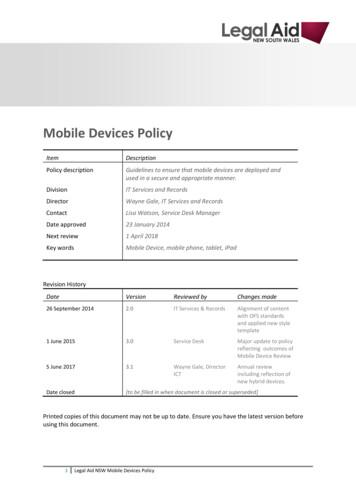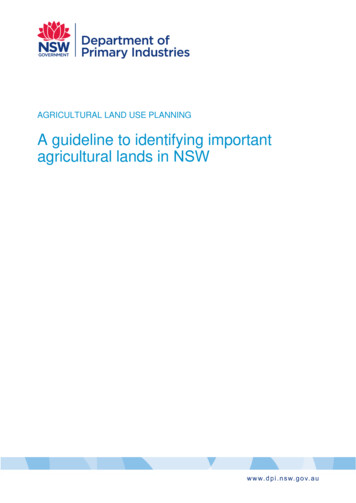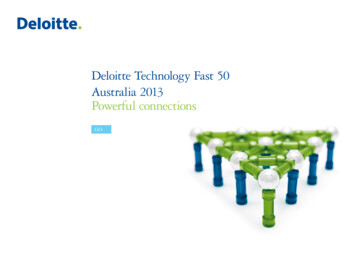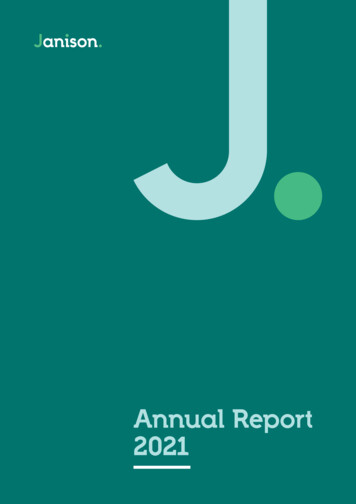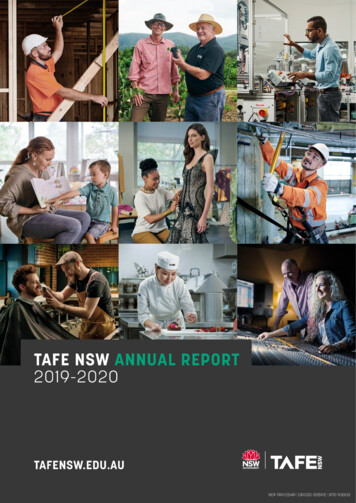
Transcription
TAFE NSW Annual Report 2019-20 i
Notes on the data presented in this reportThe annual report predominantly uses TAFE NSW data, however, data related to Student outcomes issourced from the National Centre for Vocational Education Research (NCVER) Student Outcome Survey.Vocational Education and Training enrolment data is collected by calendar year. The enrolment, completionand student outcomes data provided in the 2019–20 annual report are for the 2019 calendar year.The data within this report covers all vocational education and training and higher education courses andqualifications delivered by TAFE NSW, including course and qualifications that are government funded, feefor-service, delivered offshore and delivered on behalf of other Registered Training Organisations.Some previous annual report data may not be comparable, due to the use of different business rules inprior years.TAFE NSW Annual Report 2019-20 i
LETTER TO THE MINISTERThe Hon. Dr Geoff Lee, MPMinister for Skills and Tertiary Education52 Martin PlaceSYDNEY NSW 2000Dear MinisterOn behalf of the Technical and Further Education Commission, I am pleased to submit the TAFE NSW 2019–20 Annual Report to you for presentation to Parliament in your capacity as Minister for Skills and TertiaryEducation.The annual report and the accompanying financial statements have been prepared in accordance with theAnnual Reports (Statutory Bodies) Act 1984 and the Public Finance and Audit Act 1983.Following its tabling in Parliament, the annual report will be available to the public on the TAFE NSWwebsite at rs sincerelySteffen FaurbyManaging DirectorTAFE NSW30 November 2020TAFE NSW Annual Report 2019-20 ii
Managing Director’s MessageI am pleased to report on the financial and operational performanceof TAFE NSW in 2019–20.Against a backdrop of a ferocious bushfire season, and a globalpandemic, we continued to make significant progress towardscompleting the One TAFE modernisation reforms, and positioningTAFE NSW to remain the number one training provider in Australia.In July 2019, Ms Kerry Penton, stepped into the role of ActingManaging Director, leading the organisation while a global search fora new Managing Director was underway. During this period, MsPenton drove a focus on prioritising the consistent planning oftraining delivery across the state, ensuring TAFE NSW has a clear planthat outlines how and where we will use our training resources.In September, following a lengthy audit of our training products,assessments, and student support, the national regulator reregistered TAFE NSW as an RTO until 1 September 2025. This decision speaks to the quality and excellencethat exists within our organisation, and reaffirms our position as a trainer of choice.During the year, TAFE NSW invested in a comprehensive and ongoing capability development program tosupport teachers and assessors to demonstrate their VET currency and competency – a requirement underthe national standard. At the core of this investment, is ensuring every employee understands their rolesand responsibilities in ensuring quality delivery.TAFE NSW plays an important role in responding to immediate and emerging skills needs in communities.In February, we took the decision to offer more than 270 fee-free short courses designed to specificallyrespond to the immediate skill needs of bushfire affected communities across the state.In April, we again responded to community needs, by offering a suite of fee-free courses to help peopleand businesses affected by the COVID-19 pandemic to enable reskilling and upskilling.COVID-19 has also required TAFE NSW to make major changes to its training delivery. In March, following afour week pause, a range of online and connected delivery methods were deployed to ensure bothteachers and students could continue their study programs safely and effectively.Continuity of training delivery was a whole-of-business endeavour, involving additional investment inteacher training, the development of new teaching and learning resources, and provision of additional ICTsupport for both teachers and students.In 2019-20, TAFE NSW continued to invest in modern facilities that are adaptable, industry-leading anddigitally-enabled, officially opening three new Connected Learning Centres and commencing thedevelopment of a further eight centres in regional areas. TAFE NSW also delivered major upgrades tofacilities including multi-trades hubs in Miller and Gunnedah, and commenced construction of another twomulti-trades hubs in Coffs Harbour and Bega. TAFE NSW also announced the design for the MeadowbankMulti-Trade and Digital Hub, which will become a Centre of Excellence for Digital Technology upon openingin 2022.As Managing Director, I’m focused on ensuring that the leadership team is engaged with staff right acrossthe organisation. We have now introduced a series of all-staff live events, called Be Engaged, to seek inputand provide an overview of the actions we’re taking to improve organisational health. With the technologynow in place, TAFE NSW has also embarked on a monthly senior leadership briefing, and quarterly all staffupdates to improve employee understanding about organisational priorities and developments.TAFE NSW Annual Report 2019-20 iii
TAFE NSW looks forward to continuing its progress towards completing the One TAFE model to transformthe organisation into the gold standard of vocational education and training, not only in Australia, butaround the world.Steffen FaurbyManaging DirectorTAFE NSW30 November 2020TAFE NSW Annual Report 2019-20 iv
CONTENTSNotes on the data presented in this report . iLETTER TO THE MINISTER . iiManaging Director’s Message . iiiAbout TAFE NSW. 11.1 Our Legislation . 11.2 Our Footprint . 11.3 Our Commitment to Industry . 31.4 Our Business Environment . 3Performance and Achievements. 52.1 Achievements against the Strategic Plan 2016-22 . 5SHOWCASE . 62.2 Skilling the Workforce of the Future. 72.3 SkillsPoints – Resources and Engagement to Meet Industry Needs. 72.4 Training that Leads to Jobs . 92.5 National Disability Insurance Scheme. 92.6 Pre-employment Programs . 92.7 Apprenticeship Commencements. 102.8 VET Student Loans . 112.9 Higher Education. 112.10 Customer Satisfaction and Improvements . 132.11 Awards . 13Serving Our Students and Local Community . 163.1 Our Students . 163.2 Our Products . 163.3 Enrolments by Students . 173.4 Community Service Obligation . 183.5 Categories of Students Facing Disadvantage . 18TAFE NSW Annual Report 2019-20 v
SHOWCASE . 20SHOWCASE . 21SHOWCASE . 22Becoming Contemporary, Commercial and Sustainable . 234.1 TAFE Digital . 234.2 Commercial Delivery . 254.3 Risk Management, Insurance and Internal Audit . 304.4 Vocational Education and Training Compliance and Quality Audits . 324.5 Insurance . 324.6 Complaints and Improvements. 334.7 Research and Development . 34Senior Executives . 385.1 Management Structure . 385.2 NSW TAFE Commission Board . 385.3 Current Board Member Qualifications and Terms of Appointment. 395.4 Meeting Attendance . 455.5 TAFE NSW Commission (Senior Executive) Staff Agency . 455.6 Number of Senior Executive Breakdown by Band . 455.7 Average Remuneration by Band . 465.8 Senior Executive Positions and Qualifications . 475.9 Functional Responsibilities. 495.10 Organisational Chart . 51Human Resources . 526.1 Number of Employees . 526.2 One TAFE People and Safety Strategy . 536.3 Developing a Quality Workforce . 536.4 Workforce Diversity and Achievements . 566.5 Workplace Relations . 61TAFE NSW Annual Report 2019-20 vi
6.6 Work Health and Safety . 62Budget and Expenditure . 647.1 Funds Granted to Non-Government Community Organisations . 647.2 Technical and Further Education Commission Independent Auditors Report . 657.3 Financial Statements . 687.4 Land Disposal . 1207.5 Major Works . 1207.6 Consultants Costing 50,000 or more . 1237.7 Consultants Costing less than 50,000 . 1247.8 Timely Payment of Accounts . 1257.9 Work Related Overseas Travel . 1277.10 Budget Outline for 2020-2021 . 128Appendices . 1318.1 Changes in Legislation and Significant Judicial Decisions . 1318.2 Government Information (Public Access) Act 2009 . 1318.3 Privacy and Personal Information Protection Act 1998. 1368.4 Public Interest Disclosures . 1378.5 Internal Audit and Risk Management Attestation . 1388.6 Digital Information Security Attestation . 1398.7 Contact Details . 140TAFE NSW Annual Report 2019-20 vii
About TAFE NSW1.1Our LegislationTAFE NSW is the NSW Government's public provider of vocational education and training (VET).The New South Wales Technical and Further Education Commission (trading as TAFE NSW), was establishedas a statutory agency by the Technical and Further Education Commission Act 1990 (NSW).Under this legislation, TAFE NSW performs a number of functions, including: Providing technical and further education services to meet the skills needs of individuals and theworkforce, in ways that recognise the changing nature of workplaces and the need for new skills andretraining Consulting with industry and the community to ensure technical and further education services arerelevant to industry, business, students and other groups Providing educationally or vocationally disadvantaged groups with access to technical and furthereducation and other specialised services Providing students with the maximum opportunity to progress to further education and training bylinking their studies to further TAFE NSW courses or those of other education and training providers.1.2Our FootprintTAFE NSW delivers VET and higher education in metropolitan, regional and remote areas of NSW, interstateand overseas, including online by distance education and in the workplace.In 2019-20, TAFE NSW delivered education and training at the following locations across NSW.TAFE NSW Annual Report 2019-20 1
TAFE NSW Annual Report 2019-20 2
1.3Our Commitment to IndustryTAFE NSW also delivers enterprise solutions for customised training. This is designed for employers seekingto upskill their workforce at times and places that suit their business needs.TAFE NSW has a future-focused and customer-centric plan to contribute to the NSW economy and supportindustry through: Creating jobs Building infrastructure Boosting apprenticeships Delivering strong budgets Protecting the vulnerableTAFE NSW is committed to skilling the workforce of the future by providing quality, job-ready graduates tobusiness and industry throughout NSW, Australia and internationally.TAFE NSW designs courses in consultation with industry to ensure they are current, relevant and respondto emerging trends and technological advancements.We collaborate with over 25,000 employers to help grow a productive NSW economy and ensure ourstudents get jobs.1.4Our Business EnvironmentExternal EnvironmentThe 2019-20 year was marked by a number of challenges including the devastating summer bushfires andthe COVID-19 pandemic. These events have significantly disrupted the tertiary sector with manyinstitutions adapting to virtual delivery, deferring practical lessons or temporarily closing campuses. Despitethese challenges, the COVID-19 pandemic is also driving innovation and greater responsiveness in thesector. TAFE NSW was able to promptly adapt its training delivery to the new ways of working and learningand was successful in responding to the market through its fee-free short course initiative which hasattracted over 115,000 enrolments.While operating in a challenging environment, TAFE NSW continues to adapt its learning environment tothe new reality by implementing safety measures aligned to the evolving public health orders andincreasing flexible delivery where appropriate, including skills upgrading 5,000 teachers, over 100,000resources for connected delivery and putting in place social distancing and robust hygiene measures for allface to face delivery, which was supported by the 29 million cleaning stimulus fund provided by the NSWGovernment.A Vision for TAFE NSWTAFE NSW is committed to achieving the NSW Government’s Vision for TAFE NSW, which outlines theambition for TAFE NSW to be “strong, innovative, flexible and responsive to the community and industry asthe State’s publicly-owned vocational education and training provider.” 1The Vision confirms the leading role of TAFE NSW in setting the benchmark for training quality, training theworkforce for the jobs of the future and in areas of high demand, and supporting disadvantaged ordisengaged groups to take up vocational training.The Vision also made it clear that TAFE NSW needs to make significant changes to how it operates toremain competitive in a changing environment, and specified key reform directions and accountabilities.1NSW Government, A Vision for TAFE NSW (2016)TAFE NSW Annual Report 2019-20 3
TAFE NSW Strategic Plan and Operational PlanStrategic PlanIn 2019-20 TAFE NSW continued its transition to One TAFE and its efforts to realise the NSW Government’sVision for TAFE NSW and the goals outlined in the TAFE NSW Strategic Plan 2016-22. The Strategic Planfocuses on four goals:1. Skill the State’s workforce of the future as the provider of choice2. Being a contemporary, commercial and sustainable business3. Serve our local communities4. Develop a customer-driven, proud and productive TAFE NSW team.The TAFE NSW Strategic Plan 2016-22 provides a series of milestones for the purpose of tracking progressagainst the Strategic Plan goals.TAFE NSW’s progress towards these milestones is set out under the heading titled “Achievements againstthe Strategic Plan 2016-22 milestones”.Operational PlanTo support achievement of the Strategic Plan goals, TAFE NSW has also developed a two-year OperationalPlan 2020-22 to renew our competitive strengths and position TAFE NSW as the leading Skills provider ofchoice for learners from all backgrounds. The Plan establishes our commitment to be: Responsive & connected to our customers Flexible & engaging place to learn and work Strong & sustainable organisation.Together, the Strategic and Operational Plans will ensure that TAFE NSW continues to deliver training thatmeets the current and future skills needs of students, employers, industry and community.Smart and SkilledThe NSW Government’s reform of the state’s VET system, Smart and Skilled, commenced in January 2015.Smart and Skilled is intended to increase choice and make the NSW VET system more responsive to theneeds of industry and students. It provides government subsidies for entitlement qualifications up toCertificate III level plus selected higher-level qualifications, to support people to gain the skills they need toget a job, advance their career or continue on to further study. Fee-free training is available forapprenticeship qualifications, foundation skill qualifications and, from 1 January 2020, traineeshipqualifications. Fee-fee training is also made available to Aboriginal and Torres Strait Islander students,students with disability, and other categories of students experiencing disadvantage.Additionally, from 1 January 2020, TAFE NSW commenced the implementation of the NSW Government’sMature Aged Worker Scholarship program that provides 30,000 TAFE NSW places over four years formature aged workers looking to reskill.TAFE NSW competes with private and community training providers for contestable government trainingfunds, delivering qualifications on the NSW Skills List and targeting delivery to meet the needs of studentsand the priorities of industry and the NSW economy.The NSW Government pays a fixed price for each qualification on the NSW Skills List. Students pay the samefee for government-subsidised training, regardless of whether they study at TAFE NSW or anotherapproved training provider.Besides competing with private providers for a share of contestable funding, TAFE NSW plays a vital role indelivering non-commercial training to meet government policy objectives such as fee free courses in areasof skill shortages.TAFE NSW Annual Report 2019-20 4
Performance and Achievements2.1Achievements against the Strategic Plan 2016-22Achievements in supporting bushfire and COVID-19 recoveryThe 2019 bushfires across NSW had a devastating impact on our State. Those communities have nowadditionally been impacted by COVID-19.TAFE NSW has provided significant support to the communities and businesses impacted by bushfirethrough delivery of many fee-free courses in South, North and West regions.In line with community feedback, TAFE NSW identified additional specific courses to be offered on a feefree basis at bushfire-affected campuses to support recovery.On 3 April 2020, the Minister for Skills and Tertiary Education approved the launch of a first tranche of 21fee free courses offered by TAFE NSW. A second tranche of fee free short courses, including 13 newcourses, was announced on 30 April 2020. The courses offered in Tranche 2 ensure that training does notcreate an oversupply in any skills area in the post COVID-19 environment.TAFE NSW continues to play a strong role in the rebuilding and recovery process working with otheragencies, and is well-positioned to support regions and communities affected by fires through responsestailored to individual impacts.These significant achievements are contributing to building on TAFE NSW’s role as a public provider servinglocal communities in line with the strategic plan goals.Selected achievements to enhance service delivery and customer experience: Launched a Customer Experience Strategy and implemented a Customer Voice program to enablecustomer feedback and support improved customer experienceReceived re-registration following the Australian Skills and Quality Agency auditContinuation of the delivery of a real-time, whole of business, integrated student managementsystem that will improve effectiveness and efficiency of operationsEnhanced brand experience through continuous improvements to TAFE NSW websites and customerrelationship management systemsLaunched innovative course offerings and delivery models such as the Cyber Security microlearningmodules developed in partnership with the NSW Cyber Security Innovation Node and the Women inBusiness online program for women looking to establish a micro or small business or alreadyoperating a businessDeveloped a state-wide Multicultural Plan 2020-22 to further TAFE NSW’s commitment to people ofculturally and linguistically diverse backgrounds, including students, employees and communities inNSWReleased a three-year Aboriginal Employment Strategy, Be Empowered: Empowering AboriginalPeople through Employment, to improve representation of Aboriginal people within the TAFE NSWworkforce and career development, as well as cultural capability and accountability and communityengagement.TAFE NSW Annual Report 2019-20 5
SHOWCASECLX PROJECTDuring Semester 2 2019 the Customer Experience (CX) Team successfully undertook a pilot to test aninnovative approach to connecting students with teachers and peers within virtual classrooms calledThe Connected Learning Experience (CLX) Project. Connected Learning is where a teacher activelyleads students in different locations in real time. Unlike online training the teacher is continuouslypresent to offer students guidance within a virtual classroom.The CLX Project used Human Centred Design methodology to bring together a cross functional teamcomprised of teachers, campus staff and education quality staff to identify how to improve theexperience of Connected Learning.The project team developed a set of resources and practices that focused on developing betterexperiences using the existing technology and spaces. The testing focused on materials and in classbehaviors that support a greater sense of equity and guidance within the class which resulted in moreconfident engaged students, excited teachers and improved completion rates."I was really stressed at first because I didn't know what to expect but after a few classes, I'd ratherlearn through this way than in a face to face classroom”“I guess it's just, I don't know, more calmer. I can't explain it. But yeah, I do prefer it how I'm doing itnow than the other (face to face).”The CLX Pilot insights were critical in supporting teachers and students to make the rapid transitionfrom on-campus Face to Face training to off-campus Connected Learning, due to COVID-19.Table 1: Our Performance reports against key areas of the TAFE NSW Strategic Plan 2016–22.AreaOutcomeCourse enrolments428,000 Course completions164,000 Online subject enrolments98,000 VET graduates satisfied with training89.8%VET graduates employed or in further study84.2%NSW apprentice commencements76%NSW apprentice completions9,300 Higher Education course enrolments2,300 Higher education graduate satisfied81.0%TAFE NSW Annual Report 2019-20 6
2.2Skilling the Workforce of the FuturePlanning Mechanisms in 2019-20TAFE NSW remains focused on developing and offering qualifications that deliver improved job outcomesfor students.TAFE NSW is dedicated to ensuring that training remains relevant to students and employers. Courseswhich are no longer relevant in terms of student demand and industry need are either adapted to betteraddress current need or replaced with courses that better match demand and need.TAFE NSW is committed to continuing to be a flexible and agile public training provider, including throughthe development and introduction of new courses that meet the changing employment needs and growthmarkets. As part of this process, TAFE NSW consults with industry bodies to ensure the identified skillrequirements are met. TAFE NSW also undertakes analysis of the latest market and industry demandintelligence to inform training delivery planning. TAFE NSW also works closely with communityorganisations and groups to support disadvantaged students to take up Vocational Education and Trainingand move into jobs and higher level training.One TAFE Education and Training StrategyThe TAFE NSW Education and Training Strategy 2018-22 sets out how TAFE NSW will deliver education andtraining over five years. It clearly explains the direction and goals for the provision of vocational educationand training and higher education and will guide the actions of our business as we transition to a modern,innovative organisation that realises commercial success.The Education and Training Strategy: Sets the education and training direction and priorities for the whole of TAFE NSW for five years Supports all four goals of our Strategic Plan and provides direction for the Corporate, Regional andDigital Delivery teams Enhances the customer journey wherever and whenever a customer interacts with us Identifies significant changes ahead for the way we design and deliver education and training toensure quality teaching and learning and go
digitally-enabled, officially opening three new Connected Learning Centres and commencing the development of a further eight centres in regional areas. TAFE NSW also delivered major upgrades to facilities including multi- trades hubs in Miller and Gunnedah, and commenced construction of another two multi-trades hubs in Coffs Harbour and Bega.
